Slowly but surely, the .45 ACP is regaining its preeminent position as a personal defense round. The fact that it always was the best got lost for a while when the Pentagon had to conform to NATO’s use of the 9mm. Historically, anything adopted for the American soldier creates a lemming-like demand for the same in the civilian marketplace.
Forget that it was adopted primarily for political reasons. Forget that the 9mm never could compare with the .45 ACP as a stopper. A slew of DA/SA (double action/single action) 9mm platforms with high capacity magazines evolved and were gobbled up by an eager public. The magazines eventually begat gun laws limiting capacity, ergo the declining appeal of the nine. The U.S. subsequently bought a DA/SA .45 ACP for its special forces and, the shooting public being the shooting public, rekindled interest in the round.
It took a while for some pistol manufacturers to get with the program. They had a bunch of DA/SA platforms for the 9mm, but none of the same for the .45 ACP. There still aren’t many on the market, and some that are carrying a pretty hefty price tag. Example: Smith & Wesson’s Model 4506 and Heckler & Koch’s USP, at $787 and $761 suggested retail, respectively. We’ve tested them in the past, so this time around our focus is on the more-affordable.
Each of the three pistols in this head-to-head evaluation retail for under $670. They are the Ruger P-90, the Glock 21 and the European American Armory Witness. All of these full-size .45 ACPs are intended for defensive use.
Here are our findings:
Ruger P-90
The .45 ACP member of Ruger’s P-series line of pistols is the P-90. This $489 double action pistol has a 400-series stainless steel slide, a hard-coated aluminum alloy frame and a 4 1/2-inch barrel. It comes in a lockable plastic carrying case with two 7-round magazines. The standard version is equipped with a manual safety, while the P-90D has decocking levers.
Physical Description
None of our shooters considered the P-90 to be handsome, but its workmanship was above average. The large slide had a silver/white matte finish, while the frame was a dark gray. Each finish was uniformly done. Most metal parts had only a minor amount of play. When in battery, there was no noticeable movement of the barrel. Both of the single-column magazines were well constructed.
This Ruger’s black grip panels were made of a high-strength resin called Xenoy. Both of the panels had horizontal grooves, instead of checkering, and were cleanly molded. They were inset into the frame, providing a smooth transition. Each panel was securely held in place by one screw.
Our Judgments
During range testing, the P-90’s functioning was absolutely reliable with the ammunition we used. Both magazines were easy to load to capacity without the tool provided with the pistol. Each magazine slid readily into the unbeveled magazine well and dropped freely when released. The slide didn’t have any gripping grooves, but retracting it wasn’t a problem if the shooter grasped the slide-mounted safety levers.
In our opinion, this Ruger didn’t handle as well as the other pistols in this test. We thought it sat high in the hand, which reduced the shooter’s leverage and ability to control the muzzle. Consequently, muzzle jump was more noticeable during recoil. When brought on target, the pistol tended to point a little low. The front of the grip was long enough to accommodate all fingers of the shooting hand, and its panels afforded a non-slip grasp.
Left- and right-handed shooters could easily operate either of the dual slide-mounted manual safety levers with the thumb of their shooting hand. When pushed downward, the safety disengaged the trigger, locked the firing pin and decocked the hammer. The other safety was an internal, passive firing pin block.
None of our right-handed shooters had any problems manipulating the slide catch, a large lever on the left side of the frame, with their dominant thumb. However, this was not the case with the magazine release button at the left rear of the trigger guard. Most shooters had to shift their grip to reach and depress this button.
We thought the ungrooved 3/8-inch-wide trigger’s movement was above average. The long, smooth double action pull letoff with 10 1/2 pounds of rearward pressure. After 1/4-inch of slack and a bit of creep, the single action pull released cleanly at 4 pounds. Both modes had a minor amount of overtravel.
The P-90’s sights were somewhat snag-resistant and provided a decent sight picture, but their point of aim was 1 1/2 inches above the point of impact at 15 yards. The front was a 1/8-inch-wide post with a white dot on its face. The rear was a dovetailed blade with a white dot on either side of its 1/8-inch-square notch. It was driftable for windage adjustments only.
Although our shooters felt the size of this Ruger’s five-shot groups was nothing special, its accuracy was very consistent from load to load. Groups averaged from 2.40 inches at 25 yards with Federal 230-grain Hydra-Shok hollow points to 2.55 inches with UMC 230-grain ball ammunition.
Using an Oehler Model 35 chronograph, the P-90’s muzzle velocities measured from 833 to 998 feet per second. We considered these speeds to be very good for a .45 ACP pistol with a 4 1/2-inch barrel.
Glock 21
Glock’s full-size .45 ACP is the Model 21. This $668 striker-fired pistol’s polymer frame and integral grip has recently been modified. It now has three finger grooves on the front and a thumb depression on each side. The handgun’s other features, such as a 4 1/2-inch barrel and a Safe Action trigger, remain the same. Magazine capacity is 10 rounds.
Physical Description
We thought the Glock 21 was plain looking, to say the least, but its fit and finish was good for this type of pistol. The steel slide’s uniform non-reflective black finish was a result of a process called Tenifer, which also made the slide very hard and corrosion resistant. The black polymer frame had steel rail inserts and was cleanly molded.
As on nearly all pistols with polymer frames, there was an obvious gap between the Glock 21’s slide and frame. This gap was intentionally created to enhance the gun’s operation and didn’t adversely effect the slide-to-frame fit. Moving parts had a small to moderate amount of play.
Two double-column magazines were provided with this .45 ACP pistol. They had black polymer bodies, followers and removable floorplates. Both had the usual minor molding marks, but appeared to be well constructed.
Our Judgments
Shooters found that the Glock 21 worked reliably with one of the magazines, but not with the other magazine. When it was used, the pistol’s slide continually locked to the rear on the second to last round in the magazine, instead of on the last round as it should. Furthermore, we were only able to insert 9 rounds into this magazine, which was one less than its stated capacity.
A problem we encountered with both magazines was that each of them fit into the magazine well very tightly, especially when loaded with three or more rounds. So, neither fell freely from the well, or would even drop downward, when the magazine release was depressed. Grasping the bottom front of the magazine securely enough to pull it out of the pistol was relatively difficult because there wasn’t a half-moon cutout on the bottom of the frame’s frontstrap, like on most other Glock pistols.
The Glock 21 sat comparatively low in the hand, which we felt improved the shooter’s ability to control the gun. Pointing was the quickest and most natural of the test. People with small and medium-size hands thought the grip was too large, but they were able to establish a secure two-handed grasp.
Right-handed shooters easily reached and operated the Glock 21’s slide catch lever and magazine release button with their dominant thumb. Left-handed shooters could reach and manipulate them with their trigger finger. Both of the controls were located in their usual places on the left side of the frame and worked positively.
The ambidextrous manual safety was a lever in the middle of the trigger. If it wasn’t depressed by the shooter’s trigger finger, this safety prevented firing by blocking the trigger’s rearward movement. A passive internal firing pin block safety was also incorporated into this pistol’s design.
Movement of the Glock 21’s Safe Action trigger was, in our opinion, satisfactory for a striker-fired pistol. The first part of the trigger’s pull was smooth and comparatively light, then it became heavier and let off cleanly at 7 1/2 pounds. There was no noticeable overtravel.
We felt this pistol’s black polymer sights provided the best sight picture of the test, and were the most snag-resistant. Also, their point of aim matched the point of impact at 15 yards. The front was a triangular 1/8-inch-wide blade with a white dot on its slightly angled face. The rear consisted of a dovetailed blade with a white-outlined 1/8-inch-square notch. It was drift-adjustable for windage only.
Our shooters considered the Glock 21’s accuracy to be above average with two of the three kinds of ammunition we tried. At 25 yards, Federal 230-grain Hydra-Shok hollow points and UMC 230-grain ball achieved five-shot average groups of 1.70 and 1.80 inches, respectively. Winchester 185-grain Silvertip only managed 3.08-inch groups.
This .45 ACP’s average muzzle velocities, from 791 to 958 feet per second, were the slowest of the test. However, in our opinion, this level of performance is acceptable for defensive work.
EAA Witness
The European American Armory Witness is an Italian-made double action pistol based on the CZ-75. It is available in four calibers from 9mm to .45 ACP, with numerous options. Standard features include a 4 1/2-inch barrel, rubber grips and a steel frame. The .45 ACP version comes with one 10-round magazine.
Physical Description
Retailing for $359, the Witness acquired for this test had what EAA calls a Wonder finish. This was the result of a heat treating process, which gave the steel slide and frame a matte finish that looked something like stainless steel. The controls and other small parts were blued. Both finishes were well applied. Moving parts had a modest amount of play. The blued double-column magazine had no shortcomings.
This pistol’s grip panels were made of black rubber and had a lightly textured finish. Both were cleanly molded and trimmed. The panels were held in place by one screw apiece. Grip-to-frame mating was satisfactory, though the rubber and metal didn’t transition smoothly.
Our Judgments
This EAA looked a lot better than it performed on the range. During the slide’s forward movement after firing, we noticed that it hesitated before going into battery on almost every round. The pistol failed to chamber three times with UMC ball ammunition, and its slide failed to lock to the rear five times when the magazine was empty. There were also numerous failures to eject and feed after about 100 rounds, but both of these problems disappeared after the gun was cleaned.
Due to its inverted rails, the Witness’ slide had a low profile. This resulted in a less than normal amount of surface area for the shooter to grasp when manually operating the slide. However, the serrations on the front and back of the slide aided in gripping it.
In our opinion, handling was above average. It sat well in the hand and was a natural pointer. The grip’s shape was relatively slim for a wide-body pistol, and very comfortable. An oversized beavertail on the back of the frame prevented slide and hammer bite. Since this .45 ACP weighed several ounces more than the others in the test, it recoiled the least.
All of the controls worked smoothly. They were located on the left side of the frame within reach of a right-handed shooter’s dominant thumb. The manual safety was a large two-position lever at the rear of the frame. When moved upward to the engaged position, it locked the sear. This safety could be engaged whether the hammer was cocked or not, allowing the gun to be cocked and locked.
Since this pistol has no decocking feature, the responsibility of safely decocking the hammer on a loaded chamber rests directly on the shooter. The manual explains the procedure for decocking the hammer. It also warns that the safety functions built into the gun are bypassed during the decocking process, allowing the pistol to discharge if control of the hammer is lost.
We felt the movement of this EAA’s ungrooved 5/16-inch-wide trigger was too heavy for defensive work. After 1/4-inch of takeup and a noticeable amount of creep, the single action pull released at 5 1/4 pounds. In the double action mode, the long pull released stiffly at 12 pounds.
None of our shooters considered the Witness’ sights to be satisfactory. The front, a white 1/8-inch-wide blade with a red dot on its face, was difficult to see clearly. The dovetailed rear, a blued blade with a 1/8-inch-square notch and two white dots, wasn’t very snag resistant. This arrange-ment’s point of aim was about 1 inch high and 1 3/4 inches to the left of the point of impact.
Accuracy was, in our opinion, adequate for this pistol’s intended use. It produced five-shot average groups that ranged from 2.30 inches with Federal 230-grain Hydra-Shok hollow points to 2.95 inches with Winchester 185-grain Silvertip hollow points at 25 yards.
Muzzle velocities were satis-factory for this .45 ACP’s intended use. They averaged from 867 feet per second with UMC 230-grain ball ammunition to 976 feet per second with the Winchester load.


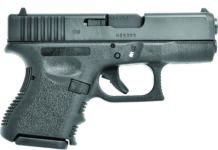
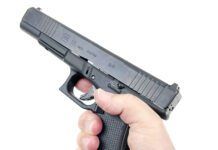
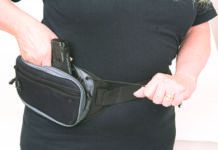




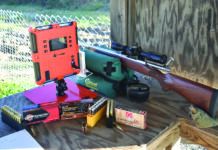

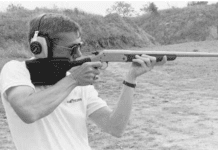







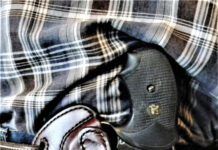

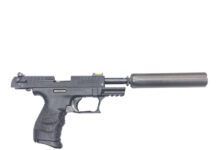


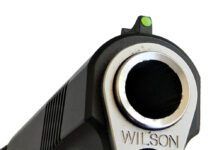


Excerpt, “Slowly but surely, the .45 ACP is regaining its preeminent position as a personal defense round.” Interesting how this article has aged since 2000.
9mm has really taken off with new bullet technology. Depts./Agencies have and are leaving the 40 S&W (and the 45 ACP) to go back to the 9mm it promises to accomplish the same task more efficiently. Additionally as shall-issue laws have spread, more people people have opted for the 9 vs the 45.
Also, I don’t think anyone saw the resurgence of .380 ACP coming (spurred by more widespread CC and the genre started by the P3AT, and improved by the LCP). Interesting how these things fluctuate. Will be interesting to see what the future holds.
old is new! try a cz 97bd sweet grip and shoots flat